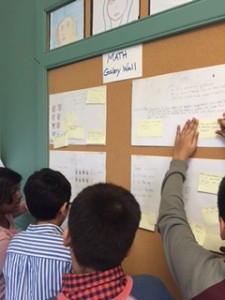One of the most important aspects of your teaching style, in my opinion, stems from the layout you choose from your classroom. The way you set up your class says a lot about you as a teacher and what you expect from your students. There is no “right” way to set up your class – just as there is no “right” way to teach a certain subject or lesson – but you should find something that really works for you.
Here are some aspects of my classroom layout that I feel are important and beneficial to my students:
1. Groups, not rows: I rarely, if ever, set my students’ desks up in rows. I teach a second language program, where oral communication is key, so giving my students time to talk to one another is paramount to their success. I usually set my students up in groups of 4-6 to allow them to face one another rather than a stark blackboard. I can easily facilitate talk time during lessons or put students in groups and be sure they have a place to work where discussion is simple and encouraged.
2. Gathering spaces, like a carpet: The reason why I’m able to keep my students in groups instead of rows is because I don’t generally teach at a blackboard. I keep a large carpeted area in my classroom (yes, at the grade 4 or 5 level!) where I can gather students together and teach a lesson. It provides an opportunity to get up and move, allows me to call on students to participate in the lesson more easily, allows all students a clear vantage point, and prevents students from fiddling with anything in their desk when they ought to be listening. Sometimes I add benches or cushions to my carpeted area to add to the comfort level, but it depends greatly on the students in my class (and whether they are likely to argue over who gets the cushions). An added bonus of having a carpeted area in your classroom is that students will often choose this space to go and work during independent periods – and for whatever reason, I find that some of my students are more focused when lying on the carpet than sitting at their desk.
3. Math manipulatives and supplies out in the open: I keep a stacked drawer unit (clear plastic) full of different types of math manipulatives. I keep another one full of school supplies (scissors, pencils, erasers, rulers, lined paper). Students are encouraged to help themselves to either of these drawer units when they need them. Having school supplies available to students just makes sense to me – they don’t have to waste their time OR mine asking me for something when they can just as easily go get it themselves. I keep the school supplies at the back of the classroom so that it isn’t disruptive when a student needs to get something. When it comes to math manipulatives, having them visible and available to students encourages them to use them even when the lesson has not explicitly called for them. They get the impression that using manipulatives is just an everyday part of math for some students, which makes them more acceptable and less stigmatized than they might be otherwise. It takes some time for students to get used to using manipulatives without it being suggested to them, but for some students it will mean the difference between comfort and discomfort in mathematics.
4. Colour: I think it’s important that classrooms feel like fun places to be. While I don’t spend exorbitant amounts of time creating decorations and elaborate bulletin boards for my classroom, I do take the time to put up coloured backgrounds on my bulletin boards with coordinating borders around the edges. I invested in some simple decorations for various times of year that I could swap out as I go through units. My colleagues often comment on how bright and welcoming my classroom is, and it’s entirely because of my orange and blue bulletin boards that they feel this way. Our students are still young, even in grade 5 or 6, and they generally like being in classrooms with some decoration.
5. Round tables: I have two round tables in my classroom that I wouldn’t give up for all the world. I use these round tables for guided reading or helping students during independent work periods. My students use these tables during group work, independent periods, or indoor recesses. I have found that some of my students who are somewhat reticent to raise their hand and ask for help while working will feel more comfortable coming to work at a round table, knowing that I will be sitting there and available to help them if they get stuck. There is less of a stigma associated with them coming to sit at the round table to work than with me sitting or standing next to them at their desk. Having this space available also allows me to call students over who need a bit more redirection or help staying on task and ask them to work at the table instead of at their seat.
Those are just a few of the key elements of my classroom layout. In my (admittedly short) career, they have proven to be effective, beneficial, and easy to manage. Hopefully someone out there will find some of those suggestions helpful for their own classroom!
Apologies for not having any photos – I’m on maternity leave and had to leave so suddenly that I didn’t get a chance to take any photos before I went off work.









